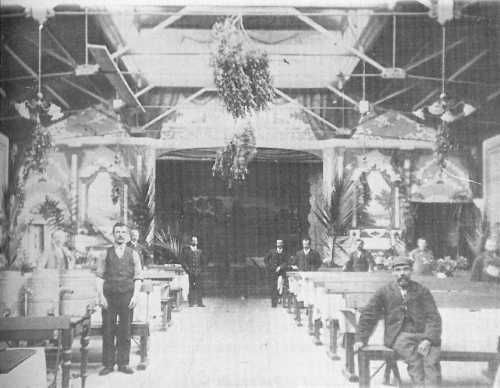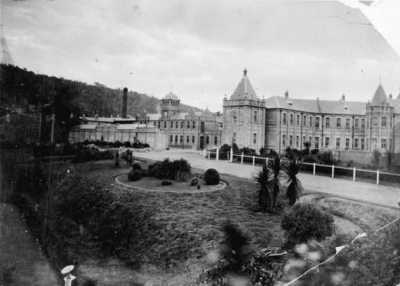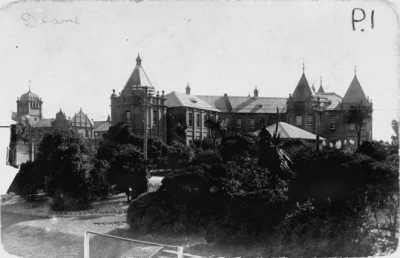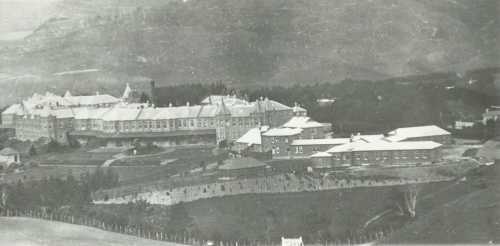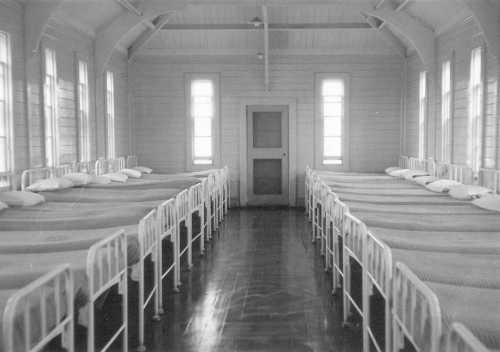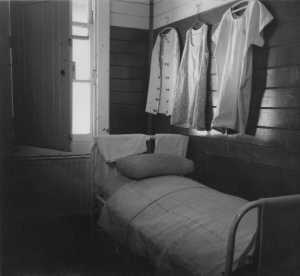The Site
The site chosen for the new asylum at Porirua was located in a rural area miles from Wellington which would be to the benefit of these ‘incurable’ patients, both as a protection from public curiosity, and as an opportunity for them to work outdoors and benefit therapeutically from the fresh air and exercise. As well it was intended that the patient labour would be used to develop a hospital farm to enable the hospital to become somewhat self sufficient and thrifty.
The first land for Porirua Hospital was acquired on 14 February 1884 from William Earp. This was Section 60 of Block V, Belmont survey in the Porirua land District together with 31 acres from Section 62 adjoining, totalling 140 acres all suitable for cultivation.
There was a good water supply from the hills behind, and the railway station on the Wellington to Manawatu railway and the harbour were close by. Later the same year another 40 acres of Section 62 were acquired and this extended the hospital estate further north towards the harbour into what is now the Central Business District of Porirua City. The land consisted of low undulating hillocks at the foot of Colonial Knob from one of which the old Main Building was to command a sweeping view of Porirua harbour, and where in time it was itself to become one of the landmarks of the district. The creek fed by the streams from Colonial Knob ran down the valley across the hospital land, and this little valley was to become the site of the hospital’s main vegetable gardens and orchard. In this valley the first building, a small cottage known as H Cottage was built in 1887. A 6000 gallon water reservoir on one of the hillocks provided an ‘excellent water supply’.
Building the Hospital
On 15 March 1886, the New Zealand Gazette announced the acceptance of the tender of John Rose, Wellington, at 1,972 pounds for the Porirua Lunatic Asylum contract. A contract was entered into on 11 October 1886 for the small asylum on the farm at Porirua. It is a one storied building covering a ground space of about 7000 square feet and containing 24 apartments of various kinds. The building was finished on 11 March within contract time.
It is almost certain that this is H Cottage, first a ward, then used as a doctors residence and then as a convalescent ward for women.
On 31 May 1887 Dr Thomas Radford King was appointed medical superintendent of both Wellington and Porirua Asylums. However within 10 months he had moved on to be replaced by Dr Gray Hassell.
In 1891 a contract was let for building the new central block for chronic patients at Porirua to accommodate over 500 patients at a total cost of 35,000 pounds. The initial contract for the central block was signed on 7 February 1891 for 17,383 pounds and construction completed a year later. Occupation with patients began even before the accommodation was completed.
Preparing for festivities in the Dining/Recreation Hall in the Main Building
In 1893 surveys were made for additional land to provide an increased water supply and further development of the hospital farm. In 1893 and 1894 a further 695 acres were acquired by the Government. This land was part of Sections 52,54, and 55 as well as Sections 122, 123, and 124 and included the land behind the hospital extending to the top of Colonial Knob, south along the valley to the present Porirua City Tip and up into the hills behind. Of this land, 195 acres were to be used as a water catchment and 500 acres for grazing sheep. A further purchase of 22 acres in 1896 brought the property to a total of ‘nearly 1000 acres’.
The new building was officially opened on 9 May 1895. It was a period of intense activity at the new asylum as other works were in progress or completed including a reservoir, a fire prevention system, a drainage system, a fire prevention system, preparation of grounds for recreation, installation of steam heating, and a hot water supply.
Developments
In September 1894 Mrs Grace Neill was appointed the first Official Visitor for Porirua Hospital, an appointment, which was made possible by the Lunatics Amendment Act of the same year which allowed women to be Official Visitors. Official Visitors were first appointed in 1868 and, like the Inspectors, were to act as independent critics. Respectable and reliable citizens, they were required to visit the asylums regularly where they had total access to listen to patients complaints and report upon their conditions and welfare. They were independent of the hospital hierarchy.
On 31 May 1887 Dr Thomas Radford King was appointed medical superintendent of both Wellington and Porirua Asylums. However within 10 months he had moved on to be replaced by Dr Gray Hassell. The ‘branch asylum’ or Farm Asylum, as it was called, was managed by John Wybourn, an attendant who had large experience of dairy farming in England. Subsequent reports stated that the farm asylum was always found in good order and was a very valuable facility for the treatment of convalescents.
1900 Construction
By 1900 the construction of the original design of the asylum to accommodate 513 patients was almost completed with dormitories, day rooms, and single rooms for the noisy patients provided on both the male and female sides. There was criticism of the materials used for the building such as the use of unseasoned timber which was shrinking, plaster breaking down, and the use of sea sand in the mortar making it friable.
In 1902 building recommenced and this time a wooden building was completed in June 1903 referred to as the auxiliary asylum. As Mount View prepared to close, further additions were required, and in 1910, F. Ward (the site of the present Hospital Museum) opened.
Staff
In 1908 the nursing staff comprised 30 nurses and 32 attendants. Senior staff at the asylum held their position for a long time. Dr Gray Hassell was Medical Superintendent from 1899 to 1920. Miss Margaret Ogilvie was Matron from 1906 until 1927. Both Mr. Barnes the Chief Attendant and Mr. Holder, Chief Clerk held their positions for many years.
Organised training for psychiatric nurses started in 1905 and in 1907 the first formal examination in psychiatric nursing took place. It was hoped this would raise the status of mental health nurses and stimulate interest in this vocation.
As part of the new initiatives in mental health care that were eventually introduced throughout New Zealand by the Mental Defectives Act 1911, the Porirua Mental Asylum became the Porirua Mental Hospital, and management of the hospital was undertaken by a Medical, as distinct from lay, Superintendent. Although activities such as farming had been part of the therapy of patients at Porirua from its opening, the Mental Defectives Act 1911 formerly introduced the concept of occupational health. This led to the adoption of the villa system whereby patients could live in accommodation located away from the main building and where they could enjoy time outdoors within a secure facility. F ward had some features of the villa system, but was always officially referred to as a ward and was either semi-detached or directly connected to the main hospital.
F Ward
F Ward was originally divided into rooms for refractory (disturbed) women mental patients. A grassed courtyard and a sun shelter, enclosed by a security wire netting fence, were provided adjacent to the building. A key advocate for this system was Dr. Theodore Grant Gray, who was appointed to Porirua Hospital in 1911 as a Junior Assistant Medical Officer to the Medical Officer to the Medical Superintendent, Dr. Gray Hassell (Superintendent from 1890 to 1920).
Gray only spent a short time at Porirua but was to later work in other New Zealand institutions. During his time at Porirua Hospital he appears to have been instrumental in instituting the state registration of psychiatric nurses. The practical effect of this was to allow for female charge nurses to be appointed to male wards.
In a letter of 15th of December 1943, F ward houses 103 women.
A nurse who worked there in 1925 remembered:
"The patients in F Ward were terribly violent. They screamed and yelled all night and half the day. There were no drugs - they were locked in single rooms and you couldn't go near them."
The photo shows one of those rooms today at the Museum. The clothing and mattress were made of canvas to prevent the patients from tearing them up and hanging themselves. Ngaere who nursed patients here in the 1930s says: “It was not really barbaric – they were not shut in and forgotten – they were moved to a clean room every twelve hours – there was no medication – there was nothing else we could do”.

